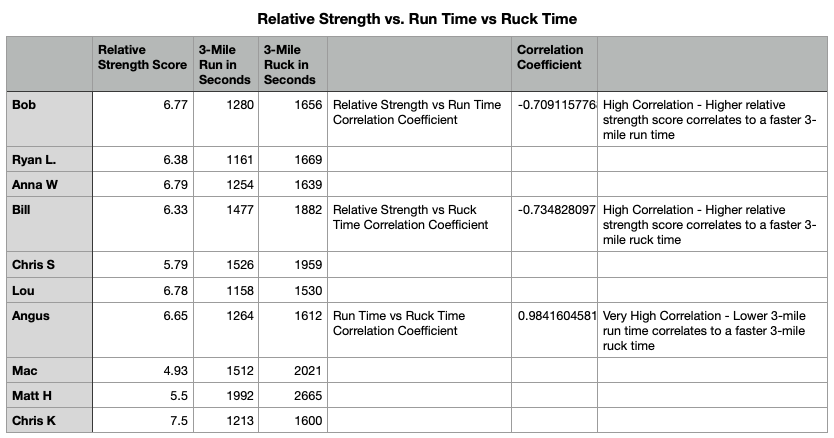By Rob Shaul
BLUF
This Mini Study re-tested the correlation between (1) relative strength and ruck speed, and; (2) 3-mile run time and ruck speed with the aim of identifying which (relative strength or running performance) had the highest correlation.
The results found that both the 3-mile run time and relative strength had a strong correlation to rucking speed. However, 3-mile run time has sightly stronger correlation.
These results are significantly different than a previous mini study which found that 6-mile run time had a much greater correlation to ruck time than relative strength.
BACKGROUND & STUDY DESIGN
Rucking, or extended movement under load, is a physical activity mode which extends across all of the athletes MTI works with: Military, Mountain, Law Enforcement and Fire Rescue. Correspondingly, we have conducted multiple ruck-focused research. Below are examples of previous studies:
- Mini Study: Run Time Correlates to Ruck Time Much Better than Relative Strength
- Mini Study Results: Apex Lab Rats Increase Strength, Strength Endurance, Run and Ruck Times
- Mini Study: Strength Emphasis and Hybrid Programming Beat Endurance Emphasis to Improve Ruck Performance
- Mini Study: Threshold Ruck Intervals Best for Developing Short Distance Rucking Speed
- Mini Study Results: Improving Heavy Rucking and Upper Body Pulling Strength in Females
- Ruck Deep Dive – Study #2: Best Ways to Improve Rucking
- Ruck Deep Dive – Study #1: Physical Attributes Which Relate to Rucking
- Valor Update: Lab Rats Increase Strength and Ruck, Run, Speed over Ground
A 2015 Mini Study found that for men, bodyweight and 2-mile run time were the best predictors of a 10K ruck effort carrying 60+ pounds.
An April, 2022 Mini Study found that 6-mile run time had a much stronger correlation to 3-mile ruck time than relative strength.
This study piggy backed and updated that April, 2022 effort by testing the predictive value (correlation) of relative strength (strength per bodyweight) and 3-mile run time, to a 3-Mile ruck effort carrying 45#.
Ten veteran MTI lab rats and athletes, over a course of 5 days, completed three assessments: (1) MTI Relative Strength Assessment; (2) 3-Mile Run (unloaded); (3) 6-Mile Ruck for Time @ 45#.
The MTI Relative Strength Assessment is a 4-event strength assessment of strength per bodyweight. The events are 1RM (1 repetition maximum) Front Squat, 1RM Bench Press, 1RM Hinge Lift and max rep bodyweight pull ups.
Below was the testing schedule:
- Mon: MTI Relative Strength Assessment
- Tue: Total Rest
- Wed: 3-Mile Ruck for Time carrying 45#
- Thur: Total Rest
- Fri: 3-Mile Run for Time (unloaded)
Post assessments, a simple correlation was performed.
MTI research is primarily focused on improving MTI programming. This study pitted Relative Strength vs. 3-Mile Run time as a predictor of rucking performance. If one stood out over the other, the results could influence the training time allocated to each in our many programs designed to prepare athletes for ruck-focused selections, events, courses and fitness assessments.
RESULTS & DISCUSSION
Below are the mini-study results:

One element of this study which perhaps skewed the results are the high levels of fitness of the lab rats. Scoring “excellent” on MTI’s Relative Strength Assessment. is no joke.
Six of the ten lab rats scored “excellent” as tactical athletes on the Relative Strength Assessments – which is likely higher than a general tactical population.
There were two differences between this mini study and the prior similar one from April 2022. This study deployed a 3-mile run vs. a 6-mile run time from April.
The second difference is in the results. The April mini study found a low correlation between relative strength and rucking speed. This study found high correlation.
NEXT STEPS
MTI’s current military selection and base fitness programming has been proven to be successful for many athletes facing ruck-based selection events and I’m hesitant to make significant changes without some more study.
Next would be a longer programming study which would compare the effect of running programming vs. strength programming on rucking improvement.
Questions? Email coach@mtntactical.com
Comments? Please enter your comment below.

